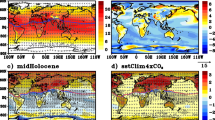Abstract
Forced by the realistic SST, an atmospheric general circulation model (AGCM) with 9 sigma levels in vertical and rhomboidal truncation at wave number 15 in the horizontal is run for 16 years with and without the Tibetan Plateau respectively(called TP and NTP experiment). The result simulated is used to investigate the influence of the Tibetan Plateau on the interannual variability of Asian monsoon. It is found that the interannual variability of Asian monsoon associated with El Nino / La Nina in NTP experiment is quite different from that in TP experiment. With the Tibetan Plateau included, the results are consistent with the observation very well. To a great extent, the anomalous variation of Asian monsoon during El Nino / La Nina period in observation is due to the existence of the Tibetan Plateau. Therefore, the topography of the Tibetan Plateau is an important factor to the interannual variability of Asian monsoon.
Similar content being viewed by others
References
Broccoli, A. J., and S. Manabe (1992), The effects of orography on the mid-latitude northern hemisphere dry climates, J. Climate., 5: 1181–1201.
Hahn, D. G. and S. Manabe (1975), The role of mountains in the South Asian monsoon circulation, J. Almos. Sci., 32: 1515–1540.
Hahn, D. G., and J. Shukla (1976), An apparent relationship between Eurasian snow cover and Indian monsoon rainfall, J. Atmos. Sci., 33: 2461–2462.
Kuo, H. L. and Qian, Y. F. (1982), Numerical simulation of the development of mean monsoon circulation in July, Mon. Wea. Rev., 110(12): 1879–1897.
Lau, K. M. and M. T. Li (1984), The monsoon of East Asia and its global association-A survey, Bull. Amer. Meteor. Soc., 65: 114–125.
Li, M. C., Wu, Y.F. and Huang, J. Y. (1987), The relationship between monsoonal rainfall over the East China and the sea surface temperature anomaly in the eastern equatorial Pacific, Scientia Atmospherica Sinica., 11(4): 365–371 (in Chinese).
Manabe, S., and T. B. Terpstra (1974), The effects of mountains on the general circulation of the atmosphere as identified by numerical experiments, J. Atmos. Sci., 31: 3–42.
Ni Yunqi, et al (1987), simulation capability and sensitivity of the regional circulation to orography in the low resolution spectral model: the summer Asian monsoon circulation, The Climate of China and Global Climate, China Ocean Press and Spring-verlag, pp 327–344.
Ni, Yunqi et al. (1995), ENSO and its influences on the Asian monsoon and the climate changes in China, Meteor Sinica, 15(4): 30–45.
Rasmusson, E. M., and T.H. Carpenter (1983), The relationship between eastern equatorial Pacific sea surface temperatures and summer monsoon rainfall over India and Sri Lanka, Mon. Wen. Rev., 111: 517–528.
Repelewski, C. F., and M. S. Halpen (1987), Global and regional scale precipitation associated with El Nino / Southern oscillation. Mon. Wea. Rev., 115: 1606–1626.
Tao, S. Y. and L. X. Chen (1987), A review of recent research on the East Asian summer monsoon in China Monsoon Meteorology. C. P Chang and T. N. Krishnamurti, Eds., Oxford University Press, 60–92.
Weare, B. C. (1979), A statistical study of the relationships between ocean surface temperatures and the Indian monsoon, J. Atmos. Sci., 36: 2279–2291.
Webster, P. J., and S. Yang (1992), Monsoon and ENSO: selectively interactive systems, Quart. J. Roy, Meteor. Soc., 118: 877–926.
Wu, Aiming and Ni, Yunqi (1997), Numerical study for the effects of Tibetan Plateau on the mean Asian monsoonal circulation, Platean Meteor, to be published (in Chinese).
Wu, Aiming and Ni, Yunqi (1997), The influence of Tibetan Plateau on the interannual variability of the atmospheric circulation over tropical Pacific, Adv. Atmos. Sci., 14(1): 69–80.
Wu, Guoxiong, Liu Hui, et al. (1996), A nine-layer atmosphere general circulation model and its performance, Adv. Atmos. Sci., 13: 1–18.
Zhang, Renhe, Akimasa Sumi and Masahide Kimoto (1996), Impact of El Nino on the East Asian monsoon: A diagnostic study of the ’86/ 87 and ’91/ 92 events, J. Meteor. Soc. Japan., 74(1): 49–62.
Author information
Authors and Affiliations
Additional information
This study is supported by the key project “Influnce of Land Process of Tibetan Plateau on Weather and Climate of China.”
Rights and permissions
About this article
Cite this article
Aiming, W., Yunqi, N. The influence of tibetan plateau on the interannual variability of asian monsoon. Adv. Atmos. Sci. 14, 491–504 (1997). https://doi.org/10.1007/s00376-997-0067-0
Received:
Revised:
Issue Date:
DOI: https://doi.org/10.1007/s00376-997-0067-0




